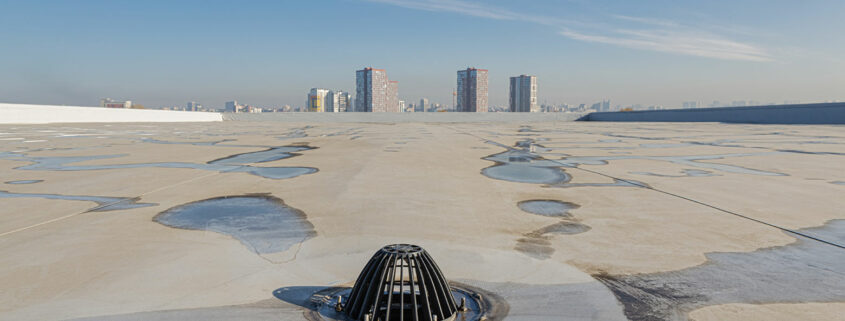When running your business, you’re not always thinking of your roof’s drainage system — until something goes wrong. Roof drains for commercial buildings range from simple to complex, depending on the type of roof. There are several types of drain systems, and they all need regular maintenance to drain water properly and keep your building’s interior dry. Learn more about commercial roof drainage and its importance in maintaining your roof.
How Roof Drains Work
No matter what type of drain it is, they all serve the same function: to direct water off of the roof surface and down to the ground. Without them, water would collect on a flat roof and stay there.
Standing water (or ponding water) can cause extensive water damage to commercial flat roofs. Water can work its way under the roof membrane, causing blisters and degrading the material. In the colder months, it can freeze and expand within the membrane to cause damage. Standing water also allows algae, mold, and mildew to grow. All of these will eventually require a roof repair.
Types of Roof Drains
Flat-roof commercial buildings will have one of two types of drainage solutions: either a gravity system or a siphonic system.
Gravity Drainage
A gravity drainage system relies solely on gravity to take water from the roof to the ground. Water flows through a strainer to filter leaves and other debris. Drain pipes under the roof handle the water flow to the ground.
Gutters
Gutters are another type of gravity drainage usually found on residential roofs (or structures with a sloped roof). Water flows down the shingles into gutters on the edge of the roof, and then to downspouts and finally, the ground.
Siphonic Drainage
Siphonic drainage systems use a baffle located on the drain to prevent air from entering the drainage pipes (with lower atmospheric pressure). When the water enters the drain and meets an area of low pressure, it’s “pulled” down faster than it would with gravity.
Outer Perimeter Drains
For water drainage along the outer perimeter of a roof, there are scuppers or scupper drains, which are openings in the parapet wall that allow water to flow down the side of the building to a gutter or downspout. On large buildings with flat or low-slope roofs, these are used in conjunction with interior drains for water drainage.
Roof Drain Maintenance
The number one enemy of roof drains is clogs, leaves, or other debris blocking the drains. This is why it’s so critical to have a reliable roofing contractor check your roof a minimum of twice a year – preferably after winter and after summer. However, it’s not a bad idea to check your roof or have it looked at after a severe storm.
When water doesn’t drain off of your roof, it becomes susceptible to a long list of problems:
-
- Ponding – In the summer, standing water (called ponding) can cause your roof material to decay as it evaporates.
- Blistering – When the seams degrade, water can work its way under the roofing membrane. As the water heats and evaporates, it causes the membrane to lift and separate from the underlying layer, forming a bubble or blister.
- Mold, Mildew, and Algae – When there’s water and warmth, unwanted life can form. These can not only damage your roof but mold and mildew can be serious health risks.
- Ice Damage – Care must be taken in the winter to make sure that drains are free from clogs and debris, otherwise severe ice buildup can occur. As the ice thaws and melts over the winter, it can damage the roof material.
Take Care of Your Roof Drains
Commercial roof drainage is the only thing between your commercial roof and severe water damage. Make sure they’re functioning right with regular checking and maintenance. Who should you turn to? The trusted expert roofers at TEMA Roofing Services have decades of experience in the commercial roofing industry. For roofing maintenance, repair, and replacement, contact TEMA today!





